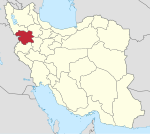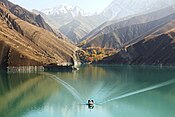Kazemi Dam
| Saqqez Lagzi Lake | |
|---|---|
 Lagzi Lake | |
| Location | Saqqez, Iran |
| Coordinates | 36°18′31.27″N 46°30′16.03″E / 36.3086861°N 46.5044528°E |
| Purpose | Power, irrigation |
| Status | Operational |
| Construction began | 1967 |
| Opening date | 1971 |
| Dam and spillways | |
| Type of dam | Dam with clay core |
| Impounds | Zarrineh River |
| Height | 50 m (164 ft) |
| Length | 720 m (2,362 ft) |
| Reservoir | |
| Total capacity | 800,000,000 m3 (648,571 acre⋅ft) |
| Power Station | |
| Installed capacity | 87 MW |
Saqqez Lagzi Lake is a lake behind a clay core dam on the Zarrineh River in the Zagros Mountains range, located near Saqqez in Kurdistan Province, western Iran.[1][2]
The reservoir and lake of the dam are located in Kurdistan province and its catchment area is from Chehel Cheshmeh and Kileh Shin mountains in Zagros mountains between Saqqez and Baneh and Divandarreh.
This lake was constructed to store water for supplying drinking water to cities, irrigation and produce hydroelectric power.[3]
Geography
In Lagzi Lake, various islands have been formed that are the habitats of animal species, especially a number of rare ones, including species of birds. Larus are one of the most important species of birds that live in the islands and around the lake, which itself has different species. This lake has surprised and delighted people and environmental experts because the habitat of these creatures is mostly on the shores of large seas and lakes.
In This Dam, Nazargah Island is the largest island in the lake. One of the advantages of these islands is the protection of rare bird species from the danger of being hunted by other animals such as wolves, snakes and foxes. Also, millions of fish are raised in this lake every year and are sent to the markets by fishermen during the fishing season.[4]
See also
References
- ^ Conflict Resolution on Water Demands from Shahid Kazemi Reservoir by a Cooperative Game Theory, CIVILCA
- ^ Saqqez Water Resources, Saqqezrudaw
- ^ Shahid Kazemi Dam, Islamic Azad University
- ^ Fish hunting in Saqqez Shahid Kazemi Dam, Young Journalists Club



